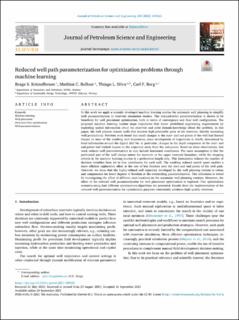| dc.contributor.author | Kristoffersen, Brage Strand | |
| dc.contributor.author | Bellout, Mathias | |
| dc.contributor.author | Silva, Thiago Lima | |
| dc.contributor.author | Berg, Carl Fredrik | |
| dc.date.accessioned | 2022-04-19T07:30:27Z | |
| dc.date.available | 2022-04-19T07:30:27Z | |
| dc.date.created | 2021-11-22T12:57:23Z | |
| dc.date.issued | 2021 | |
| dc.identifier.citation | Journal of Petroleum Science and Engineering. 2021, 208 (C),109523, 10. | en_US |
| dc.identifier.issn | 0920-4105 | |
| dc.identifier.uri | https://hdl.handle.net/11250/2991219 | |
| dc.description.abstract | In this work we apply a recently developed machine learning routine for automatic well planning to simplify well parameterization in reservoir simulation models. This reduced-order parameterization is shown to be beneficial for well placement optimization, both in terms of convergence and final well configuration. The proposed machine learning routine maps trajectories that honor predefined engineering requirements by exploiting spatial information about the reservoir and prior domain-knowledge about the problem. In this paper, the well planner creates wells that traverse high-permeable parts of the reservoir, thereby increasing well productivity. Previous work found that small changes to the start- and end-points of the well had limited impact on most of the resulting well trajectories, since development of trajectories is chiefly determined by local information around the digital drill bit. In particular, changes in the depth component of the start- and end-points had limited impact on the trajectory away from the end-points. Based on these observations, this work reduces well parameterization to only include horizontal coordinates. The main assumption is that the perforated part of the well always enters the reservoir at the upper reservoir boundary, while the stopping criteria in the machine learning routine is a perforation length only. This formulation reduces the number of decision variables from six to four coordinates for each well. The resulting reduced search space enables a more efficient exploration effort at the cost of less freedom over the start and end points of the well path. However, we show that the highly-refined well trajectory developed by the well planning routine is robust and compensates for fewer degrees of freedom at the overarching parameterization. This robustness is tested by investigating the effect of different start locations on the automatic well planning routines. Moreover, the effect of the reduced well parameterization for well placement optimization is explored. Two optimization scenarios using four different optimizations algorithms are presented. Results show the implementation of the reduced well parameterization for optimization purposes consistently produces high quality solutions. | en_US |
| dc.language.iso | eng | en_US |
| dc.publisher | Elsevier | en_US |
| dc.rights | Navngivelse 4.0 Internasjonal | * |
| dc.rights.uri | http://creativecommons.org/licenses/by/4.0/deed.no | * |
| dc.subject | Well parameterization | en_US |
| dc.subject | Derivative-free optimization | en_US |
| dc.subject | Well placement | en_US |
| dc.subject | Machine learning | en_US |
| dc.title | Reduced well path parameterization for optimization problems through machine learning | en_US |
| dc.type | Peer reviewed | en_US |
| dc.type | Journal article | en_US |
| dc.description.version | publishedVersion | en_US |
| dc.rights.holder | © 2021 The Author(s). Published by Elsevier B.V. This is an open access article under the CC BY license | en_US |
| dc.source.pagenumber | 10 | en_US |
| dc.source.volume | 208 | en_US |
| dc.source.journal | Journal of Petroleum Science and Engineering | en_US |
| dc.source.issue | C | en_US |
| dc.identifier.doi | 10.1016/j.petrol.2021.109523 | |
| dc.identifier.cristin | 1957278 | |
| dc.relation.project | Norges forskningsråd: 262644 | en_US |
| dc.source.articlenumber | 109523 | en_US |
| cristin.ispublished | true | |
| cristin.fulltext | original | |
| cristin.qualitycode | 2 | |

